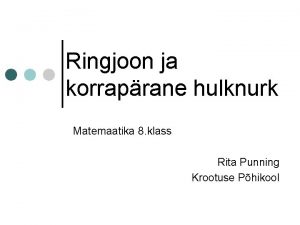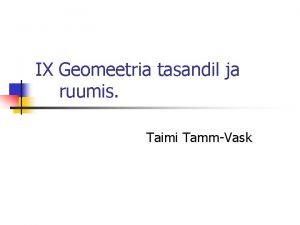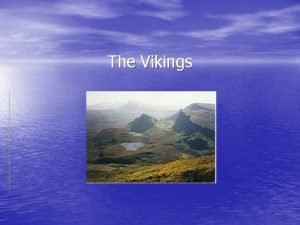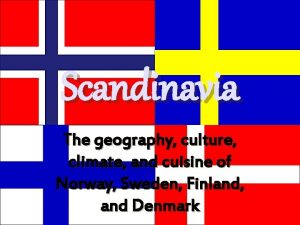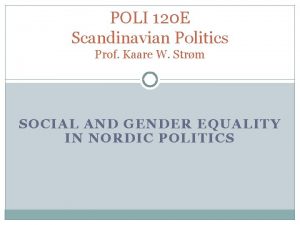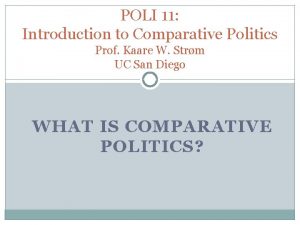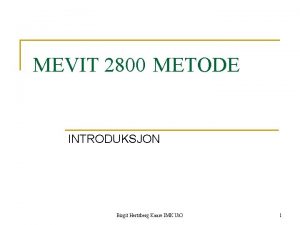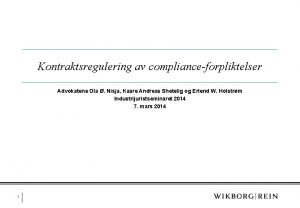POLI 120 E Scandinavian Politics Prof Kaare W














- Slides: 14

POLI 120 E Scandinavian Politics Prof. Kaare W. Strøm FROM CONFLICT TO PEACE AND DEMOCRATIZATION: NORDIC POLITICAL HISTORY, 1523 -1900

Domestic Political Transformations, 1500 -1680 2 � Protestant Reformation of 1530 s Rapid and complete in DK, slower in S � Decline of Assembly Tradition � Trend toward Absolute Monarchy DK absolutism 1660 S absolutism 1680 � Centralization of Power 1536: Norway and Iceland lose their independence, incorporated into Denmark � Administrative Reform More efficient tax system Appointed administrative officials (sheriffs)

Sweden at its Territorial Peak: The Treaty of Roskilde, 1658 3 � Repeated wars between Denmark and Sweden � Both countries pursue Great Power status in the 1600 s � Denmark has the stronger navy; Sweden the stronger army � Sweden gradually emerges as the dominant power from 1620 s � 30 -year War, 1618 -48 � 30 -year War and four additional wars lead to Danish defeats, loss of Skåne (Battle of Lund 1675)

Rivalry and Prominence, 4 1520 -1718 � Two dominant and ambitious monarchs: Christian IV and Gustavus II Adolphus � Christian IV (1588 -1648): Longest-serving Danish monarch; builder and warrior; founded and rebuilt various fortifications and cities, including Oslo (Christiania), travelled widely and launched colonial projects in North America and Sri Lanka; had at least 24 children (7 by his 1 st wife, 12 by his 2 nd, and at least 5 by various others) � Gustavus II Adolphus (1611 -32): made Sweden a great power, one of the greatest military commanders in history, inherited a kingdom at war at the age of 16. � 30 -year War, 1618 -48 Devastating, ruinous conflict, originally about rulers’ right to choose religious denomination (Catholics vs. Protestants) 1625: Intervention of Danish king Christian IV on the Protestant side proves disastrous, eventually bankrupts Denmark 1630: Gustavus II Adolphus intervenes and saves Protestant forces 1632: Gustavus II Adolphus killed in battle, war of attrition lingers on into stalemate 1648: Treaty of Westphalia ends war; Catholics gain territory at the expense of Protestants

The Rise of Sweden, 1520 -1718 5

The Absolute Monarchy 6 � Absolute Monarchy From Elective to Hereditary Monarchy Absolutism (after French model – Louis XIV) � Denmark, 1660 -1849 under Frederik III � Sweden, 1680 -1718 under Carl XI � Decline of Parliaments Weaker constraints on kings Royal charters lose their importance Iceland, Norway: Parliaments cease to function � Sweden: Strong monarchs overreach (Carl XII 1697 -1718)

The Great Nordic War, 1700 -1718 7 � Continuous war between Denmark and Sweden, 1520 -1718 � Gradual emergence of Sweden as great power, with large Baltic possessions � 30 -year War brought conflict with Russia as well as Denmark � Carl XII – the (last Swedish) warrior king � 1718: The Great Nordic War ends Death of Carl XII End of Swedish Great Power status End of two centuries of constant conflict between Denmark and Sweden Beginning of democratization in Sweden (“Age of Liberty” 1718 -72)

Nordic Political History 1718 -1800: Diverging Paths: Sweden – The Age of Liberty 8 1718 -72: The Age of Liberty � 4 -Chamber Parliament dominates the king � New constitution adopted 1719 -23 favored nobility � Emergence of two-party politics: Hats (Nobility) vs. Caps (Farmers, Clergy) � Similar to Britain in gradual evolution of constitutional monarchy, parliamentary democracy � 1772: Coup by King Gustav III, more autocratic constitution; king later assassinated (as portrayed in the opera “A Masked Ball” by Verdi) � Painting: Arvid Horn, Riksdag Speaker

Diverging Paths 1718 -1800: Denmark 9 - Ineffective Autocrats 1660 -1849: Absolute Monarchy Danish Paradox: Strong monarchy, weak monarchs � Frederik V (1746 -66): Unwilling to rule � Christian VII (1766 -1808): Unable to rule � Late 1700 s: Rule by royal advisors, bureaucrats � 1784: Crown Prince Frederik assumes power through a coup � Napoleonic wars: Disastrous foreign policy mistakes by King Frederik VI � 1800 s: Monarchy increasingly criticized by liberalizers

The Napoleonic Wars, 1792 -1814: The Danish Tragedy 10 � Denmark and Sweden try to protect their neutrality with important maritime interests � 1800: “Free ports” alliance with Russia and Prussia � 1801: British bombardment of Copenhagen (Admiral Nelson) � 1807: Second British bombardment of Copenhagen; 160 ships seized; Denmark joins Napoleon’s side and leaves Sweden as Britain’s only ally in the north � 1814: Napoleon’s defeat leads to Treaty of Kiel: Denmark cedes Norway (excl. ICE, GL, and the Faroe Islands) to Sweden

The Napoleonic Wars, 1792 -1814: Changing Swedish Fortunes 11 � 1807: Sweden loses last possessions in Germany to France � 1808: Russia attacks Sweden and captures Finland � 1809: Mutiny against Swedish King Gustav IV Adolf, who abdicates, eventually leading to the emergence of King Carl XIV Johan (Bernadotte) � 1809: In peace treaty Sweden cedes Finland to Russia, as Grand Duchy; adopts new liberal constitution; joins Napoleon’s enemies � 1814: In Treaty of Kiel: Denmark cedes Norway (excl. ICE, GL, and the Faroe Islands) to Sweden � 1814: Norway rebels, adopts liberal constitution, forced into dual monarchy with Sweden, but keeps constitution

The Legacies of the Napoleonic Wars 12 � Political Downsizing Denmark loser, Sweden wins some and loses some, but both Scandinavian powers reduced to small-power status � Democratization 1809 Swedish Constitution 1814 Norwegian Constitution Until 1975 the oldest living constitutions in the world after the U. S. Gradual rise of liberal forces in Denmark (Constitution in 1849) � Nationalism Rise of nationalism in Norway, Finland, and later Iceland � End of Nordic Wars No more wars between Nordic countries No civil wars except Finland 1918 Strengthening of tradition of neutrality Beginning of Scandinavianist movement

Main Themes of Nordic Modernization, 1814 -1945 13 Scandinavianism (mainly 1829 -64) Nationalism in Finland, Norway, Iceland, 1800 -1945 Democratization, 1814 -1921 Industrialization, 1850 -1950

Peace and Scandinavianism 14 � Scandinavianism, 1845 -64 A solidarity movement among intellectuals Influenced by romanticism 1829: Danish poet Adam Oehlenschläger crowned by Swedish Bishop Esaias Tegnér in Lund � Nationalism in Finland, Norway, Iceland � Dano-Prussian wars of 1848, 1864 disillusioned many supporters, including Norwegian playwright Henrik Ibsen � WWI: All countries adopt neutrality, supported by Malmö meeting of three kings � 1945 -: Nordic integration efforts, incl. Nordic Council (1952)
 Kaare skagen
Kaare skagen Aisoni poeg
Aisoni poeg Korrapärane kolmnurk
Korrapärane kolmnurk Risttahuka kõrguse leidmine
Risttahuka kõrguse leidmine What separates europe from asia
What separates europe from asia Icca scandinavian chapter meeting 2021
Icca scandinavian chapter meeting 2021 Westfjord 29 nordic
Westfjord 29 nordic Scandinavian explorers
Scandinavian explorers Scandinavian climate and geography
Scandinavian climate and geography Rim organization
Rim organization Scandinavian berry
Scandinavian berry Scandinavian jobs
Scandinavian jobs 120px x 120px
120px x 120px 100+80+40
100+80+40 Umass poli sci
Umass poli sci


